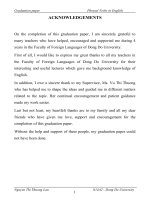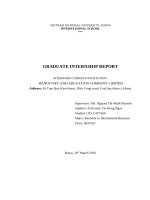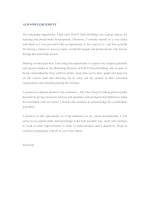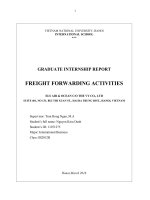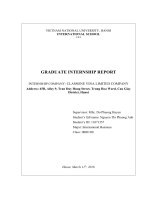Báo cáo thực tập tiếng anh TABLE OF CONTENTGRADUATE INTERNSHIP REPORT INTERNSHIP COMPANY AUTO VIET TECHNOLOGY JSC
Bạn đang xem bản rút gọn của tài liệu. Xem và tải ngay bản đầy đủ của tài liệu tại đây (305.88 KB, 33 trang )
VIETNAM NATIONAL UNIVERSITY, HANOI
INTERNATIONAL SCHOOL
***
GRADUATE INTERNSHIP REPORT
INTERNSHIP COMPANY: AUTO VIET TECHNOLOGY JSC.
Address: 26/121, group 14B, Thai Thinh lane, Thinh Quang ward, Dong Da district,
Ha Noi
Supervisor: Ms. Tran Hong Ngan
Student’s full name: Vu Thi Thuy Anh
Student’s ID: 11071161
Major: International Business
Class: IB2012B
Hanoi, March 11th, 2016
2
ACKNOWLEDGEMENTS
On my internship report, it is my chance to thank all the people who made this
period an unforgettable experience in my life.
First, I am very thankful for the board of director of AUTO VIET, who gave me
the chance to work in an impressive environment.
Second, I should thank to the staffs of AUTO VIET for supporting and to have a
great internship period. Especially, I also appreciate to my sponsor - Mr. Nguyen Dang
Hung– for providing me appropriate guidance and training.
And finally, I am very grateful my supervisor – Ms. Tran Hong Ngan – for the
efforts to supervise and give me the direction to explore a new environment. Thanks to
her, I have crucial comments to successfully complete this report.
3
ABBREVIATIONS
JSC
Joint Stock Company
Ltd
Limited
PET
Polyethylene terephthalate
VAMA
Vietnam Automobile Manufacturers Association
GSO
General Statistics Office
L/C
Letter of Credit
B/L
Bills of Lading
4
Table of Contents
1.
The formation and development history of Auto Viet Technology
Joint Stock Company
1.1.
General information of Auto Viet Technology Joint Stock Company
Name
Auto Viet Technology Joint Stock Company
Transaction name
AUTO VIET., JSC
Charter capital
VND 6,000,000,000
Head quarter’s address
26/121, group 14B, Thai Thinh lane, Thinh Quang
ward, Dong Da district, Ha Noi, Vietnam
Showroom’s address
38 Yen Lang street, Dong Da district, Ha Noi,
Vietnam
Tel
+8439912992 – Fax: +8439912882
Website
/>
Business license date
February 25, 2009
Business operation since
April 01, 2009
Legal representative:
Nguyen Dang Hung
5
1.2.
Development process
Before 2009
In the period of 2006-2008, Vietnam automobile market developed quite
strongly, thus the demand of car furniture increased substantially both in quantity and
quality.
After his graduation from National Economics University, Mr. Nguyen Dang
Hung (current director) had worked for some automobile companies and had
accumulated a lot of experiences as well as some capital to establish his own company.
After getting the business license on February 25th 2009, on April 1st 2009, Auto Viet
Technology Joint Stock Company has been officially established and operating.
Formerly, the company primarily performed their task to seek the products from
worldwide reputable brands such as: leather upholstery, insulation films and alloy
wheels… Most of these products were imported based on customers’ orders and in
need for specific kinds of their cars. The demand has not been required a lot yet since
they needed furniture for replacement of the old or damaged ones. The primary market
was only Ha Noi and contiguous provinces. The personnel of the company at that time
were only 4 people and the number of technical workers was 6.
The period from 2009 to present
Because of increasing demand from customers and views on needs to own a car
with maximum comfort and meet all the needs of the aesthetic features. Taking this
into consideration, the company has developed much more products and services: highend audio equipment, luxurious wood-paneled interiors, accessories for pickups,
guarantee, advisory… The company extended their market into other provinces such
as: Hai Duong, Hai Phong, Quang Ninh, Nghe An, Ha Tinh…
On May 6th 2012, the company opened a showroom on Yen Lang Street, Dong
Da, Ha Noi to provide advisory, guarantee and larger place for assembly and repair.
6
1.3.
Auto Viet Technology JSC’s business sectors
1.3.1. Import and sell:
- High-end leather upholstery Jackspeed imported directly from Singapore
1.3.2.
-
used in airplanes, yachts, cars (BMW, Mercedes…)
Genuine alloy wheels
High-end audio equipment (Sony, JVC, Alpine…) in cars
Luxurious wood-paneled interiors
Accessories for pickups imported from Thailand (Carryboy, TFT,
-
AEROKLASS, ALPHA…)
BOSCH accessories
Car care products
Decorations for cars
Exclusive distributor in Ha Noi for heat insulation film Nano Blue Diamond
– FSK, 10 year guarantee
Services
- Guarantee
- Car care advisory
- Assembly and repair
1.3.3. Auto Viet JSC’s featured products
a. Leather upholstery Jackspeed
Products are imported directly from Jackspeed Singapore PTE Ltd.
7
-
Quality Assurance: All leathers are selected from tanneries certified by
-
strict automotive standards before intensive tests to ensure durability.
The Perfect Fit: With Automotive Manufacturers certified procedures and
standards, Jackspeed’s team of qualified technicians guarantee the best
-
craftsmanship from sewing to installation of the brand new upholstery.
ISO/TS 16949: A quality management system that is recognized by OEMs
(Original Equipment Manufacturers) worldwide and its conformance
prerequisite of all suppliers. It applies to the design/development,
-
production, installation and servicing of automotive-related products.
Side Airbag Certification: Leather Seat Covers with Integrated Side Airbag
-
certified by TUV Kraftfahft Gmbh – German Safety Monitoring Agency.
ISO9001:2008: A global quality management standard used to establish an
-
organization quality management system.
ISO14001:2004: An environment management standard that serves to help
-
organizations better in protecting the environment and preventing pollution.
OHSAS 18001: A British standard for occupational health and safety
management that is recognized globally.
b. Heat insulation film Nano Blue Diamond – FSK
- Place of origin: Shanghai, China
8
-
Manufacturer: Shanghai Yongguan Adhesive Products Co., Ltd.
Material:
PET
Function:
Decorative, Explosion-proof, heat insulation
Feature:
Self-adhesive
Color:
Various/Customized
Transmittance: 5-80%
Structure:
2 ply
Width:
20”(50cm), 30”(75cm), 40”(100cm), 60”(1524cm)/max
Length:
12”(30cm) to 100ft (option choice)
Durability:
3 years
Applications: Solar control films are mostly used for automobiles and
buildings. As its name means literally, the films are for blocking ultra violet
rays, from entering the enclosed area by applying these films on to the
-
window of automobiles or buildings. (The films block 98-99% of UV rays.)
Excellences:
Reduces heat, glare and fading of interior furnishings
Tough and durable with scratch resistant hard coating
High quality film, easy to install
Not affected by condensation
Suitable for single and double glazed windows
Can be removed when no longer required
Well packed to ensure that it will reach you in good condition
PART 2: IMPORT OPERATIONS IN AUTO VIET TECHNOLOGY JOINT
STOCK COMPANY
Figure 01 - Auto Viet JSC’s hierarchy structure
9
Director
Accounting Department
2.
Vice Director - Sales
Vice Director - Import
Sales Department
Import Department
Personnel Department
Import Department’s functions and missions
2.1.
Functions
Advising the Director on import and searching for the markets all over the world
to expand operations and imported goods
2.2.
Missions
-
Perform the import processes
Make annual import plans and submit to Vice Director; propose solutions
-
and resources to Director to ensure that accurate plans be carried out
Develop strategy for the product structure, import market based on the
-
diversification of business sectors
Circulate and archive import documents, settle the import contracts.
2.3.
-
Relations
Co-ordinate with Sales Department in products sales operation
Work with Accounting Department and Personnel Department.
10
2.4.
Import operations
2.4.1. Market research
a. Domestic market research
The car furniture and accessories market in Vietnam is dependent on the
automobile market. Therefore, this research may also be undertaken with the latter one.
i.
Some “special” characteristics of the automobile market of Vietnam in recent
years
- Imperative follow: “Follow” here means to race for introducing new car
models, which means if there are any new models in major and developed
markets, then right after that, those models would be introduced or
-
assembled in Vietnam.
Not hesitate to spend money: In the information technology boom nowadays,
whenever there are new or incomparable car models anywhere, Vietnamese
car buyers grasp very quickly. They are prepared willing to spend millions
-
dollars to possess luxury cars:
Still waiting for prices: Comparing to regional markets, the car prices in
Vietnam is twice or thrice higher. Automobile joint ventures confirmed that
the prices are high taxes (about half the price of each sold car). There is
another opinion that in 2018 the car prices in Vietnam would be much lower
since the import tax and accessories in ASEAN would decline sharply.
ii.
The facts of automobile market in Vietnam
• Supply
Automobile supply of Vietnam nowadays is quite huge and it is from a lot of
different sources. Most of the supplies are from three main sources:
-
Domestic manufacture and assembly
Import
11
-
Smuggling
In these three sources, according to statistics in the past few years, domestic
manufacture and assembly accounted for the largest number, followed by import and
then smuggling.
According to General Statistics Office (GSO) of Vietnam, in December 2015,
there were about 14,000 cars imported into Vietnam; the turnover was about 382
million USD.
In 2015, the total number of cars imported was about 125,000 with the turnover
of 2.97 billion USD, increased 76.6% in the amount of cars imported and increased
87.7% in value. (baochinhphu.vn)
The domestic manufactured and assembled cars were supplied essentially by
VAMA with 18 members: Toyota, Truong Hai, Ford, Mercedes Benz, Daewoo…
Annually each joint venture manufactures about 3,000 cars, this amount of cars only
supplies for domestic market. It shows that the quantity of domestic manufactured and
assembled cars is not enough for consumers’ demand even in domestic market, which
makes imported cars market is still quite exciting.
However, according to GSO, after applying new calculation of excise tax, the
amount of imported cars in January 2016 decreased for 50% with only 7,000 cars,
while there were 14,000 cars imported in December 2015. According to some import
cars enterprises, this new calculation of excise tax make the price of cars adding some
cost such as: transport, advertisement, labor…
The remaining of the total supplies of the automobile market is from smuggling.
This amount of cars has significant impact to the market because of low prices, thus it
has high competitive advantage.
12
•
Demand
Although Vietnam has gained remarkable accomplishments in innovation of the
economy, Vietnamese people’s income is not high, the GDP is 2,109 USD while the
price of a domestic manufactured and assembled is about 60,000 USD, the demand of
Vietnam automobile market is still quite modest with the ratio 1 car/100 people.
Moreover, the streets in Vietnam do not coincide with circulating by cars, which make
the demand of people to use cars is not high.
Researching on market demand means that we have to understand that which products
the market would need in the present and future, amounts and prices. Based on
consumers’ tastes and trends in each automobile segment, we need to take these
researches into consideration to import furniture and accessories which are comply for
-
them.
Class A: City car - small, low price, suitable for women: Kia morning, Chevrolet
-
Spark, Hyundai i10…
Class B: Subcompact car – affordable prices, less fuel consumption, easy to drive,
stable with 500km driving, safer than city car. A lot of first car buyers choose this
class.
Hatchback: Toyota Yaris, Ford Fiesta, Mitsubishi Mirage, Kia Rio, Mazda 2S, Suzuki
-
Swift…
Sedan: Toyota Vios, Nissan Sunny, Honda City, Mitsubishi Attrage…
Class C: Compact car: Toyota Corolla Altis, Honda Civic, Ford Focus, Mazda 3,
Hyundai Elantra, Kia K3…
Class D: Mid-size car
Mid-size cars in Vietnam are all in sedan model (there is also hatchback model in
foreign countries) because of popular taste of elegance and noble. Customers for this
segment are mainly young businessmen, businesses, wealthier households…
Toyota Camry is still considered as the most purchase-worthy car model for its
design, reputation and low care cost. Its competitors are Mazda 6, Hyundai Sonata, Kia
Optima, Nissan Teana, Honda Accord… in which the most prominent are Mazda 6 and
13
Hyundai Sonata because of their youthful style, modern technology and lower price
than Camry.
- Compact MPV:
Compact MPV is very popular in Vietnam thanks to its affordable price, large
space inside, low maintenance cost… Toyota Innova is dominating in this segment
since its debut in 2006. It is the best choice for passenger carrier, taxi agencies,
businesses and individuals for car rental, mid-class family who often travel with 5-7
people…
Competitors: Chevrolet Orlando, Mitsubishi Zinger, Nissan Grand Livina,
Suzuki Ertiga… and imported cars such as Ford C-Max, Mazda 5…
-
MPV or Minivan: Toyota Sienna, Honda Odyssey, Kia Sedona…
Crossover: Ford Escape, Kia Sportage, Hyundai Tucson, Mitsubishi Outlander Sport,
-
Suzuki Grand Vitara…
And luxurious car models such as: Mercedes Benz C-Class, E-Class, S-Class, GLKClass, ML-Class, GL-Class; BMW 3-Series, 5-Series, 7-Series, X3, X5; Audi A4, A6,
-
A8, Q5, Q7; Jaguar XF, Lexus LX570, Cadillac Escalade…
Pickup: Ford Ranger, Mazda BT-50, Toyota Hilux, Mitsubishi Triton, Nissan Navara,
Chevrolet Codorado…
Government’s policies for import products:
• Tax bases and tariff
According to Law on import and export duty No.19/VBHN-VPQH:
Article 8.Tax bases, tax calculation methods and the tribute money
1. Tax bases of export, import duty is the number of units of each item actually
exports and imports recorded in customs declaration forms, tax price and tax rate
percentage (%); for items subjected to absolute tax, the tax base is the number of units
of each item actually exports, imports recorded in customs declarations and the
absolute tax rate provided for a unit of item.
2. Tax calculation methods are defined as follows:
14
a) Number of export tax, import tax to be paid by the number of units of each item
actually exports and imports recorded in customs declaration forms multiplied tax price
and tax of each item recorded in Tariff in time of tax calculation;
b) In the case of items subjected to absolute tax, export tax and import tax must to
be paid by the number of units of each item actually exports, imports recorded in
customs declarations multiplied absolute tax rates regulated on a unit at the time of tax
calculation.
3. Tax payment is Vietnam dong; in cases of tax payment in foreign currency, it
shall be paid in freely convertible foreign currency.
Article 9.The tax price and taxable exchange rate
2. The tax prices for imported goods are the prices actually paid at the first entry
gate under contract, in accordance with international commitments.
3. The exchange rate between Vietnam dong and foreign currencies used to
determine the taxable price is the exchange rate by the State Bank of Vietnam
announced at the time of tax calculation.
Government regulations specify in detail the dutiable provisions in this article.
Article 10.Tax rates
2. The tax rate for imported goods including preferential tax rates, special
preferential tax rates and ordinary tax rates:
a) The preferential tax rates are applicable to imported goods originating from
countries, groups of countries or territories made to most favored nation (MFN)
treatment in trade relations with Vietnam;
b) The special preferential tax rates are applicable to imported goods originating
from the countries or groups of countries or territories implemented special preferential
import tariffs with Vietnam;
c) The ordinary tax rates applicable to imported goods originating from the
countries or groups of countries or territories that do not grant MFN treatment and nonimplementation of special preferential import tax to Vietnam. The ordinary tax rates
are defined not exceed 70% preferential tax rate in each respective item specified by
the Government.
• VAT for company’s products
15
The tax rate shall be applied under the Circular No.83/2014/TT-BTC guiding the
implementation of value added tax for the list of imported goods Vietnam in which
most imported products of Auto Viet JSC’s are applied with 10% VAT.
b. Foreign market research
This process requires the company to know about how many suppliers for intended
imported goods and supply ability, transaction and payment method… These factors
affect on the import stability and durability.
The price of commodity includes cost of goods sold, packaging cost, transportation
cost, insurance cost and others’ cost that depend on the process and the agreements
between both parties. In fact, the price of each kind of commodity is affected by a lot
of elements such as: competition, supply and demand, inflation, season… Therefore,
the company needs to consider and determine the impact of all the factors on the prices
of imported goods, hence determine the reasonable prices for domestic consumers and
for them to achieve their goals. In the imported goods prices selection issue, the
company usually based on the prices: in traditional trading center, in main production
countries or focused manufacturers, exchange rate, political environment, law, trading
practice and currency system.
Auto Viet JSC has trade relations mainly with Thailand, China, Singapore and
Taiwan. Among those, Thailand is the biggest business partners which accounts for 39
percent of total trading volume, followed by China (30 percent), Singapore (21
percent) and Taiwan (7 percent). This can be explained that Thais products have good
quality and most reasonable price than ones from other countries.
Source: Auto Viet’s report
16
2.4.2. Negotiation and signing contract
a. Negotiation
This is the beginning stage of the formation of the contract. Both parties’
representatives would meet each other to express their requests and desires. This stage
requires both parties to elaborate the preparations to have beneficial agreements for
both in negotiation while keeping good and stable relationships in business.
For the first trading, Auto Viet JSC’s directorate often administrate to direct
negotiation method in which the director or vice director would go to Thailand,
Singapore, China… to directly meet, communicate and present the requests and
inquiries to solve immediately. After both parties gain conversance and trust in each
other, we can use the negotiation method by media such as fax and email… to save
time and cost.
Negotiation process includes following steps:
-
Enquiry: a request to enter the transaction from the buyer to request the
seller to provide the information about the goods and services. An enquiry’s
contents does not need to be complete like a contract but still assure some
-
basic terms such as: product name, quantity, quality, price, delivery period.
Offer: a suggestion from the seller. An offer’s contents ensure the contents
-
of a contract. There are two main types of offers: free offer and fixed offer.
Order: a proposal to conduct transaction from the buyer and bind the
obligations to the seller. An order’s contents ensure the contents of a contract
-
including the clauses of technical requirements or a sample attachment.
Counter-offer: Counter-offer can be sent from buyer or seller. Legally, this is
an answer but not a complete acceptance for previous transaction clauses.
This is commercially also the bargain for price and transaction clauses.
17
-
Acceptance: a completely unconditional acceptance with all the requests
from the other party. An acceptance with an offer or an order counts as
-
signing the contract.
Confirmation: to confirm the clauses with both parties had agreed and this
confirmation counts as an agreement to sign the contract.
b. Signing contract
The usual contents of a contract for import include:
-
Contract number
Date, place signing contract and term of contract performance
Both parties’ information: address, telephone number, account number, bank
Contract’s article
Commodity, Specification, Quantity, Quality, Packing
Shipment: time, place, method
Payment: method, currency
Other clauses
The contract applies Incoterms 2010.
2.4.3. Implementation of an import contract
Open L/C (if payment
Make a carriage
Obtain an insurance
with L/C)
contract
contract
Customs procedures
Payment
Unload the goods
Claim procedures (if
needed)
a. Open L/C (if payment with L/C)
After signing contract (normally via fax), Auto Viet JSC would proceed to escrow
and open L/C at JSC Bank for Foreign trade of Vietnam (Vietcombank) or Vietnam
Maritime Commercial Joint Stock Bank (Maritime Bank) Ha Noi branch and send the
18
copy of L/C (deferred 30-60 days) via fax. Partial shipment is allowed; trans-shipment
is not allowed.
Required documents for payment often include:
-
Commercial invoice
Bill of lading
Packing list
Certificate of origin
Certificate of insurance
Certificate of manufacturer
DHL’s invoice informs that the original document or copy is sent to the buyer.
At the same time, based on shipment clauses, the company informs the carrier agency
to arrange schedule and the time they go to the seller’s warehouse to take the goods.
Auto Viet urges the Seller to prepare and give the goods to the carrier on time, then
they requests the Seller to send the documents to them for preparation of import
procedures documents, contacts the carrier agency to get the receiving note as soon as
possible and obtains an insurance contract if the goods need insurance.
When the goods are arrived at Haiphong port, Auto Viet contracts the carrier
agency to get the notice of arrival and prepare the documents to unload the goods
including:
Contract
Copy of L/C
Bill of lading
Commercial invoice
Certificate of origin
Packing list
b. Make a carriage contract
-
Making a carriage contract is based on three conditions:
19
-
Contract’s clauses
Commodities’ features
Transport conditions
FOB: The buyer makes the carriage contract.
CIF: The seller makes the carriage contract.
Auto Viet JSC commissions this to DHL – a carrier agency.
c. Obtain an insurance contract
Vietinbank Insurance for import and export cargo:
The
Coverage
Under the Cargo insurance rules of seaborne transport of VBI and ICC "A", "B", "C" of
the Association of Insurance London , 01/01/1982.
The coverage
1. Loss or damage occur may reasonably attributed to:
Fire or explosion
Boats and barges were stranded, sunk or capsized
Vehicles inland are overturned or derailed
Collisions or crashing into any objects except for water
Unloading at the port of refuge
Insurance Conditions
A
X
X
X
X
X
B
X
X
X
X
X
C
X
X
X
X
X
X
X
X
X
X
O
2.Loss or damage caused by:
Liability under the term "mutually at fault collisions”
Earthquakes, volcanic eruptions and lightning
Sea, lake or river water entering the vessel, barge, cargo
transporting container or storage
Commodity being swept from vessel
Bad weather
Spontaneous action or intentional actions
Pirates
Special risks
War risk
Strike risk
3.The reasonable costs
X
X
X
X
X
X
D
D
X
X
O
O
O
O
D
D
O
O
O
O
O
O
D
D
20
General damage sacrifice
Throwing goods into the sea for lighter vessels (when
in danger)
General damage contributions
Salvage Cost
X
X
X
X
X
X
X
X
X
X
X
X
X: Insured
O: Not insured
D: Insured with an additional charge
The special risks include:
Goods damaged by rainwater and/or freshwater
Damage caused by with other commodities
Stolen, not delivered
Damage caused by acid
Leakage, uncompleted commodity delivery
Damage caused by rodents
Collapsed, broken, arcuated, crushed
Damage caused by mold
Damage caused by using hooks
Rust
Damage caused by nails
Condensation of moisture and heat
Damage caused by rubbing or scratching
Self-ignition
Damage caused by oil and/or grease
Contamination.
The formula for calculating the fees is as follows:
CIF = (C + F) / (1-R)
I = CIF x R
(Where in, I: Insurance Premium, C: Cost, F: Freight, R: Insurance rate)
The insurance rate depends on the commodities, packing type, transportation, insurance
conditions route.
Insurance
fee
-
Step 1: After signing the contract and opening L/C, the staff informs the
insurance company: contract number, L/C number, name of commodities
and insured value.
21
-
Step 2: Provide the copy of B/L, invoices and packing list to the insurance
-
company,
Step 3: Receive insurance certificate.
Step 4: Inform the representative of insurance company to check the amount
of damage commodities (if happened) and hire inspectors from Vinacontrol
to inspect the good quality.
d. Customs procedures
Fill in Custom declaration form (electronic/paper) the following details:
Name of commodities, Quantity, Volume, Value, etc
Means of transportation, Export countries.
e. Payment
- In case of payment by transferring money: payment on time under the
-
-
contract
In case of payment by L/C: when the original documents are sent to the bank
issued (Vietcombank or Maritime Bank), Auto Viet checks the documents in
5-7 days. If the documents are valid, the company pays L/C with bank.
- Auto Viet receives the documents to unload the goods
f. Unload the goods
To unload the goods from a foreign country, Auto Viet do the following:
-
Sign a commission contract with the carrier agency (DHL).
Confirm with DHL about the commodities acceptance plan for each quarter,
each year, commodities structure, vessel schedules, technical conditions
-
while unloading the goods, delivery, shipping and receiving.
Present the required documents (B/L, delivery order…) if the vessel does not
-
give them to the carrier agency.
Supervise the procedures, urge the carrier agency to make a report (if
needed) for the goods and resolve the problems in receiving within the
-
company’s limits.
Pay with DHL for the costs of loading, preservation and delivery.
22
-
Transfer the goods to Auto Viet’s warehouse.
Quantity and quality check
According to Decree 200-CP December 31 st 1973 and interdepartmental
(Transportation – Foreign trade) circular No.52/TTLB January 25th 1975, imported
goods must be checked carefully at the gate. Each agency depending on its function
performs their task to check. If finding or having suspicions that goods are damaged,
then ask the inspector to check. Carrier agency, Haiphong port agency and inspector
agency make a report on the vessel. The report does not bring up the cause of damage
but only the conditions of goods.
g. Claim procedures (if needed)
- Claim period: based on the contract’s clause on agreements; in case there is
not Claim procedures article in the contract, according to Vietnam
Commercial Law, claim period is three months for quantity, six months for
-
quality from the first unloading of goods.
Claim to:
The seller: the goods are not correct with the contract in quantity and
quality. The goods are damaged because of inappropriate packaging.
Carrier: the goods are lost or partial lost. The goods have problems
with well-founded reasons.
Insurance company: the goods are damaged or lost caused by
disasters, people...
Claim documents file include: claim letter, inspector report, underselling report,
unload report, bill of lading, commercial invoice, insurance.
23
PART 3: INTERNSHIP GOALS, ASSIGNED TASKS AND PERFORMANCES
3.1. Internship goals
Have the practical work experience
Develop and learn more skills
Understand about how import process works and what to conduct in each step
Experience the work environment
-
3.2. Assigned tasks and performances
Wee
k
Date
Jan 18 –
Jan 22 /
1
Tasks performed
-
Searching company’s background.
Reading company’s documents (import).
-
Reading, arranging and understanding documents
2016
(contracts, commercial invoice, packing list, bill of
Jan 25 –
2
Jan 29 /
-
2016
Feb 15 –
3
Feb 19 /
2016
lading, VAT invoice…).
Searching for information of the Seller from
Thailand.
-
Scanning old contracts.
Researching law and policies that applies for
articles in contracts.
24
Wee
k
Date
Feb 22 –
4
-
Learning about shipment and payment methods and
-
insurance of the company.
Practicing making documents.
-
Learning about customs procedures by the online
Feb 26/
2016
Feb 29 –
5
Tasks performed
Mar 04/
form on the website of customs departments and go
2016
to the customs department with a staff to observe
the procedures.
Mar 07 –
6
-
Synthesize all the reports and documents of a
-
complete import process.
Go to the bank with a staff to practice opening L/C.
Mar 11/
2016
25
PART 4: ACHIEVEMENTS
4.1. Strengthened theories
-
Incoterms 2010
Preliminary Considerations of Importing about identification of suppliers,
import packing and labeling, method of transportation and booking
-
transportation, and payment.
Import process and documentation: draft for payment, arrival notices, notices of
redelivery, request for information, customs audits, and court of international
trade.
4.2. Practical skills experiences
-
Write formal emails to suppliers to make enquiries.
Book transportation with DHL
Open L/C at Vietcombank
Understand documents that I have not understood before.

